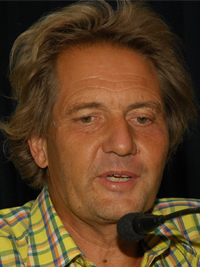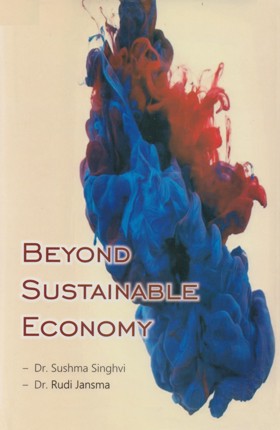The Self, Ātman, Rooh, Soul or Spirit, our true essence as it is involved in its mundane pilgrimage, goes always with attachment to attributes (parigraha). These are given up after a long journey of many lives (aparigraha). Passing from one life to another is called rebirth.
Serious scientific researches show that there is lot of empirical basis for the concept of rebirth.
The famous Indian case of Shanti Devi is one of the most famous reincarnation case on record. On January 18, 1902, Chaturbhuj, a resident of Mathura, was blessed with a daughter, who was named Lugdi. When Lugdi reached the age of 10 she was married to Kedarnath Chaube, a shopkeeper of the same locality. It was the second marriage for Kedarnath, as his earlier wife had died. Kedarnath Chaube owned a cloth shop in Mathura and also a branch shop at Hardwar. Lugdi was very religious and had been to several pilgrimage places at a very young age. While on one pilgrimage, she injured her leg for which she had to be treated, both at Mathura and later at Agra.
When Lugdi became pregnant for the first time, her child was stillborn following a Cesarean section. For her second pregnancy, the worried husband took her to the government hospital at Agra, where a son was born, again through a Cesarean, on September 25, 1925. Nine days later, however, on October 4, Lugdi's condition deteriorated and she died.
One year, ten months and seven days after Lugdi's death, on December 11, 1926, Babu Rang Bahadur Mathur of Chirawala Mohulla, a small locality of Delhi, had a daughter, who they named Shanti Devi. She was just like any other girl except that until the age of four she did not speak much. But when she started talking, she was a different girl - she talked about her "husband" and her "children."
She said that her husband was in Mathura where he owned a cloth shop and they had a son. She called herself Chaubine (Chaube's wife). The parents considered it a child's fantasy and took no notice. They got worried, however, when she talked repeatedly about it and, over time, narrated a number of incidents connected with her life in Mathura with her husband. On occasions at meals, she would say, "In my house in Mathura, I ate different kinds of sweets." Sometimes when her mother was dressing her, she would tell what type of dresses she used to wear. She mentioned three distinctive features about her husband: he was fair, had a big wart on his left cheek, and wore reading glasses. She also mentioned that her husband's shop was located in front of Dwarkadhish temple.
By this time Shanti Devi was six years old, and her parents were perplexed and worried by these statements. The girl even gave a detailed account of her death following childbirth. They consulted their family physician, who was amazed how a little girl narrated so many details of the complicated surgical procedures. The mystery, thus, continued to deepen. The parents started thinking that these memories might have been of a past life.
As the girl grew older, she persisted in asking her parents to be taken to Mathura. One day a distant relation, Babu Bishanchand, wrote a letter to Pandit Kedarnath Chaube, detailing all the statements made by Shanti Devi, and asked him to visit Delhi. Kedarnath replied confirming most of her statements and suggested that one of his relatives, Pandit Kanjimal, who lived in Delhi, be allowed to meet this girl.
A meeting with Kanjimal was arranged, during which Shanti Devi recognized him as her husband's cousin and gave a number of details with regard to Lugdi's life.
On November 13rd, 1935, Kedarnath along with his second wife and the child born to Lugdi visited Rang Bahadur. Kedarnath asked whether she could tell them anything unusual to establish full faith in her. Shanti replied, "Yes, there is a well in the courtyard of our house, where I used to take my bath."
After dinner, Shanti asked Kedarnath, "Why did you marry her?" referring to his present wife. "Had we not decided that you will not remarry?" Kedarnath had no reply.
Gandhi appointed a committee of 15 prominent people, including parliamentarians, national leaders, and members from the media, to study the case. The committee persuaded her parents to allow her to accompany them to Mathura. They left by rail with Shanti Devi on November 24, 1935. The committee's report describes some of what happened:
"As the train approached Mathura, she became flushed with joy and remarked that by the time they would reach Mathura the doors of the temple of Dwarkadhish would be closed. Her exact language was,'Mandir ke pat band ho jayenge,' so typically used in Mathura.
The committee members took her in a tonga, instructing the driver to follow her directions. On the way she described the changes that had taken place since her time, which were all correct. She recognized some of the important landmarks which she had mentioned earlier without having been there.
As they neared the house, she got down from the tonga and noticed an elderly person in the crowd. She immediately bowed to him and told others that he was her father-in-law, and truly it was so. When she reached the front of her house, she went in without any hesitation and was able to locate her bedroom. She also recognized many items of hers. She was tested by being asked where the "jajroo" (lavatory) was, and she told where it was. She was asked what was meant by "katora." She correctly said that it meant paratha (a type of fried pancake). Both words are prevalent only in the Chaubes of Mathura and no outsider would normally know of them.
One of the committee members, Pandit Neki Ram Sharma, asked her about the well of which she had talked in Delhi. She ran in one direction; but, not finding a well there, she was confused. Even then she said with some conviction that there was a well at that spot. Kedarnath removed a stone at that spot and, sure enough, they found a well. As for the buried money, Shanti Devi took the party to the second floor and showed them a spot where they found a flower pot but no money. The girl, however, insisted that the money was there. Kedarnath later confessed that he had taken the money out after Lugdi's death.
The publication of the committee's report attracted worldwide attention. I met Shanti Devi, first in February 1986 and then in December 1987, and interviewed her in detail about her past-life memories and her recollections at Mathura. I also interviewed her younger brother, Viresh Narain Mathur, who had accompanied her to Mathura on her first visit. Then I went to Mathura and asked her various relatives to describe when Shanti Devi first visited them at the age of nine. I also interrogated a close friend of Kedarnath who gave me some explicit information about the way Kedarnath became convinced that Shanti was actually his wife in her past life.
During my investigations, a friend of Kedarnath, 72-year-old Pandit Ramnath Chaube, told me of a very significant event, which I confirmed from other sources. When Kedarnath was in Delhi to meet Shanti Devi, he stayed at Pandit Ramnath Chaube's place for one night. Everyone had gone to retire, and only Kedarnath, his wife, his son Navneet, and Shanti were in the room; Navneet was fast asleep. Kedarnath asked Shanti that when she was suffering from arthritis and could not get up, how did she become pregnant. She described the whole process of intercourse with him, which left Kedarnath in no doubt that Shanti was his wife Lugdi in her previous life. When I mentioned this incident to Shanti Devi during my interview with her, she said, "Yes, that is what fully convinced him."
Shanti Devi's case is also significant for the fact that it is one of the most thoroughly investigated cases, studied by hundreds of researchers, critics, scholars, saints, and eminent public figures from all parts of India and abroad from the mid-1930s on.
I close my acount of Shanti Devi's case with the remarks of Dr. Ian Stevenson, leading authority on reincarnation, who said: "I also interviewed Shanti Devi, her father, and other pertinent witnesses, including Kedarnath, the husband claimed in her previous life. My research indicates that she made at least 24 statements of her memories that matched the verified facts."
I have files of more then 500 children who had claimed to recall past live. Most of them had memories sometimes various psychological traits and even birthmarks of defects related to a past life.
It seems 'parigrah' persists from one life to another till moksha /kevalya/nirvana the state of utter liberation or aprigraha is attained.
 Dr. Kirti Swaroop Rawat
Dr. Kirti Swaroop Rawat
 Dr. Rudi Jansma
Dr. Rudi Jansma
